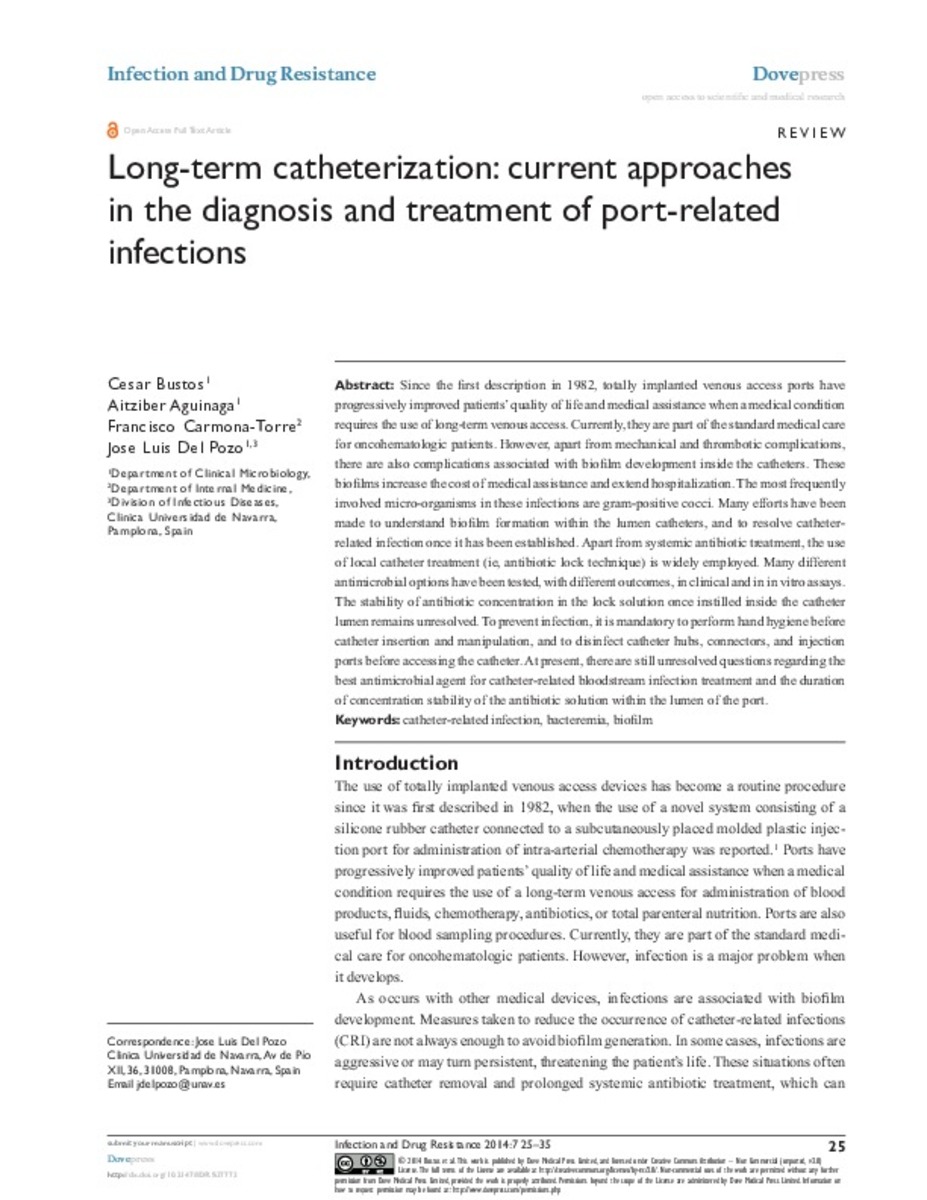Registro completo de metadatos
| Campo DC | Valor | Lengua/Idioma |
|---|---|---|
| dc.creator | Bustos, C. (César) | - |
| dc.creator | Aguinaga, A. (Aitziber) | - |
| dc.creator | Carmona-Torre, F. (Francisco de A.) | - |
| dc.creator | Pozo, J.L. (José Luis) del | - |
| dc.date.accessioned | 2014-08-30T17:29:23Z | - |
| dc.date.available | 2014-08-30T17:29:23Z | - |
| dc.date.issued | 2014 | - |
| dc.identifier.citation | Bustos C, Aguinaga A, Carmona-Torre F, Del Pozo JL. Long-term catheterization: current approaches in the diagnosis and treatment of port-related infections. Infect Drug Resist. 2014 Feb 18;7:25-35 | es_ES |
| dc.identifier.issn | 1178-6973 | - |
| dc.identifier.uri | https://hdl.handle.net/10171/36419 | - |
| dc.description.abstract | Since the first description in 1982, totally implanted venous access ports have progressively improved patients' quality of life and medical assistance when a medical condition requires the use of long-term venous access. Currently, they are part of the standard medical care for oncohematologic patients. However, apart from mechanical and thrombotic complications, there are also complications associated with biofilm development inside the catheters. These biofilms increase the cost of medical assistance and extend hospitalization. The most frequently involved micro-organisms in these infections are gram-positive cocci. Many efforts have been made to understand biofilm formation within the lumen catheters, and to resolve catheter-related infection once it has been established. Apart from systemic antibiotic treatment, the use of local catheter treatment (ie, antibiotic lock technique) is widely employed. Many different antimicrobial options have been tested, with different outcomes, in clinical and in in vitro assays. The stability of antibiotic concentration in the lock solution once instilled inside the catheter lumen remains unresolved. To prevent infection, it is mandatory to perform hand hygiene before catheter insertion and manipulation, and to disinfect catheter hubs, connectors, and injection ports before accessing the catheter. At present, there are still unresolved questions regarding the best antimicrobial agent for catheter-related bloodstream infection treatment and the duration of concentration stability of the antibiotic solution within the lumen of the port. | es_ES |
| dc.language.iso | eng | es_ES |
| dc.publisher | Dove Medical Press | es_ES |
| dc.rights | info:eu-repo/semantics/openAccess | es_ES |
| dc.subject | Bacteremia | es_ES |
| dc.subject | Biofilm | es_ES |
| dc.subject | Catheter-related infection | es_ES |
| dc.title | Long-term catheterization: current approaches in the diagnosis and treatment of port-related infections | es_ES |
| dc.type | info:eu-repo/semantics/article | es_ES |
| dc.identifier.doi | http://dx.doi.org/10.2147/IDR.S37773 | es_ES |
Ficheros en este ítem:
Estadísticas e impacto
Los ítems de Dadun están protegidos por copyright, con todos los derechos reservados, a menos que se indique lo contrario.






